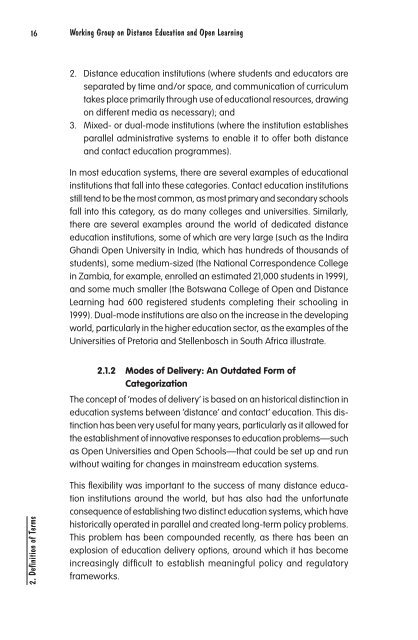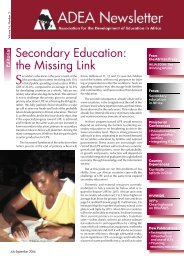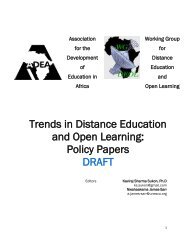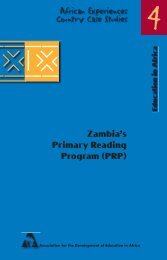Technological Infrastructure and Use of ICT in Education in ... - ADEA
Technological Infrastructure and Use of ICT in Education in ... - ADEA
Technological Infrastructure and Use of ICT in Education in ... - ADEA
Create successful ePaper yourself
Turn your PDF publications into a flip-book with our unique Google optimized e-Paper software.
16 Work<strong>in</strong>g Group on Distance <strong>Education</strong> <strong>and</strong> Open Learn<strong>in</strong>g<br />
2. Distance education <strong>in</strong>stitutions (where students <strong>and</strong> educators are<br />
separated by time <strong>and</strong>/or space, <strong>and</strong> communication <strong>of</strong> curriculum<br />
takes place primarily through use <strong>of</strong> educational resources, draw<strong>in</strong>g<br />
on different media as necessary); <strong>and</strong><br />
3. Mixed- or dual-mode <strong>in</strong>stitutions (where the <strong>in</strong>stitution establishes<br />
parallel adm<strong>in</strong>istrative systems to enable it to <strong>of</strong>fer both distance<br />
<strong>and</strong> contact education programmes).<br />
In most education systems, there are several examples <strong>of</strong> educational<br />
<strong>in</strong>stitutions that fall <strong>in</strong>to these categories. Contact education <strong>in</strong>stitutions<br />
still tend to be the most common, as most primary <strong>and</strong> secondary schools<br />
fall <strong>in</strong>to this category, as do many colleges <strong>and</strong> universities. Similarly,<br />
there are several examples around the world <strong>of</strong> dedicated distance<br />
education <strong>in</strong>stitutions, some <strong>of</strong> which are very large (such as the Indira<br />
Gh<strong>and</strong>i Open University <strong>in</strong> India, which has hundreds <strong>of</strong> thous<strong>and</strong>s <strong>of</strong><br />
students), some medium-sized (the National Correspondence College<br />
<strong>in</strong> Zambia, for example, enrolled an estimated 21,000 students <strong>in</strong> 1999),<br />
<strong>and</strong> some much smaller (the Botswana College <strong>of</strong> Open <strong>and</strong> Distance<br />
Learn<strong>in</strong>g had 600 registered students complet<strong>in</strong>g their school<strong>in</strong>g <strong>in</strong><br />
1999). Dual-mode <strong>in</strong>stitutions are also on the <strong>in</strong>crease <strong>in</strong> the develop<strong>in</strong>g<br />
world, particularly <strong>in</strong> the higher education sector, as the examples <strong>of</strong> the<br />
Universities <strong>of</strong> Pretoria <strong>and</strong> Stellenbosch <strong>in</strong> South Africa illustrate.<br />
2.1.2 Modes <strong>of</strong> Delivery: An Outdated Form <strong>of</strong><br />
Categorization<br />
The concept <strong>of</strong> ‘modes <strong>of</strong> delivery’ is based on an historical dist<strong>in</strong>ction <strong>in</strong><br />
education systems between ‘distance’ <strong>and</strong> contact’ education. This dist<strong>in</strong>ction<br />
has been very useful for many years, particularly as it allowed for<br />
the establishment <strong>of</strong> <strong>in</strong>novative responses to education problems—such<br />
as Open Universities <strong>and</strong> Open Schools—that could be set up <strong>and</strong> run<br />
without wait<strong>in</strong>g for changes <strong>in</strong> ma<strong>in</strong>stream education systems.<br />
2. Def<strong>in</strong>ition <strong>of</strong> Terms<br />
This flexibility was important to the success <strong>of</strong> many distance education<br />
<strong>in</strong>stitutions around the world, but has also had the unfortunate<br />
consequence <strong>of</strong> establish<strong>in</strong>g two dist<strong>in</strong>ct education systems, which have<br />
historically operated <strong>in</strong> parallel <strong>and</strong> created long-term policy problems.<br />
This problem has been compounded recently, as there has been an<br />
explosion <strong>of</strong> education delivery options, around which it has become<br />
<strong>in</strong>creas<strong>in</strong>gly difficult to establish mean<strong>in</strong>gful policy <strong>and</strong> regulatory<br />
frameworks.

















